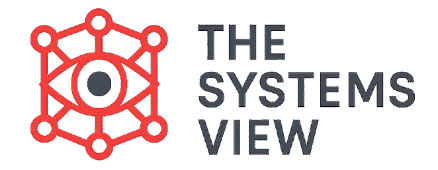We’ve explored Personal Mastery, Mental Models, Shared Vision, and Team Learning. Now, we arrive at the discipline that Peter Senge calls the Fifth Discipline which is Systems Thinking.
You might know that Systems Thinking is a way of looking at how things are connected. It’s about seeing the whole picture, not just individual pieces. In a learning organization, Systems Thinking is especially important because it helps everyone understand how all the other disciplines work together. It’s the “glue” that holds everything in place, allowing the organization to learn and grow in a truly deep and lasting way.
What is Systems Thinking (in Senge’s Context)?
In Peter Senge’s view, Systems Thinking is about understanding your organization as a living, interconnected system. It means:
- Seeing Connections: Instead of just seeing separate events or problems, you see how everything is linked. For example, a budget cut in one department might lead to quality problems in another.
- Understanding Patterns: You look beyond just what happened (an event) to see patterns of behavior over time.
- Finding Root Causes: You try to understand the deeper reasons why things happen, not just what symptoms appear. This helps you avoid quick fixes that don’t last.
Think of an organization like a human body. You can’t understand how a hand works without understanding how it connects to the arm, the brain, and the rest of the body. Systems Thinking helps you see these vital connections.
Why is Systems Thinking the “Fifth Discipline” and So Important?
Peter Senge calls Systems Thinking the “Fifth Discipline” because he believes it ties all the others together and truly makes an organization capable of learning.
- It Integrates Everything: Personal Mastery, Mental Models, Shared Vision, and Team Learning are powerful on their own. But without Systems Thinking, they might just lead to small, disconnected improvements. Systems Thinking helps you see how these four disciplines combine to create a smarter, more adaptive whole organization.
- It Reveals Leverage Points: Systems Thinking helps you find “leverage points.” These are small changes in the system that can lead to huge, positive results across the entire organization. It’s like finding the right key to unlock a big door.
- It Avoids Quick Fixes: Often, when we see a problem, we rush to fix just that one thing. Systems Thinking teaches us that “today’s problems come from yesterday’s solutions.” A solution to one problem might create new, worse problems somewhere else if you don’t see the whole system.
- It Fosters Deeper Learning: By understanding how everything is connected, the organization can learn not just what happened, but why it happened within the larger context. This leads to much deeper and more lasting learning.
Important: Systems Thinking is about moving from seeing individual “events” to understanding the deeper “patterns” and “structures” that create those events. This shift in thinking is critical for real change.
How to Practice Systems Thinking (for a Learning Organization)
Practicing Systems Thinking means changing how you look at problems and situations within your organization:
Seeing Interconnections
Don’t just look at one problem in isolation. Ask yourself: “What else might this be connected to?” “Who else is affected?” “What caused this before?” Think about circles of cause and effect, rather than straight lines.
Focusing on Structure, Not Just Events
Instead of just reacting to daily “events” (like a dip in sales), try to understand the underlying “structure” of the system (like a sales process that isn’t working or a changing market). The structure often causes the patterns of events.
Identifying Feedback Loops
Understand how actions create reactions that feed back into the system.
- Reinforcing (Positive) Loops: Actions that make a trend grow (e.g., happy customers lead to more sales, which leads to more happy customers).
- Balancing (Negative) Loops: Actions that try to bring things back to a goal or balance (e.g., quality problems lead to checks, which fix quality problems). Seeing these helps you understand why things sometimes get better or worse, or stay stuck.
Looking for Leverage Points
Once you understand the system, look for places where a small change can make a big difference. These are often not obvious places. For example, training a few key people might have a bigger impact than trying to fix everyone at once.
Considering Long-Term Consequences
Think beyond immediate results. What will happen to the system in 6 months, a year, or five years if we make this change? Systems Thinking encourages a long-term view.
Systems Thinking and the Other Disciplines
Systems Thinking is the core that makes the other four disciplines truly powerful in a learning organization:
- It helps individuals practicing Personal Mastery see their own role within the larger system, understanding how their actions contribute to the whole.
- It allows teams to challenge their Mental Models by seeing how those models might limit their view of the entire system.
- It helps refine the Shared Vision by showing how the organization’s current structure might prevent it from reaching that vision, and what systemic changes are needed.
- It enhances Team Learning by providing a common language and tools for teams to understand complex organizational problems together.
Systems Thinking in Action (in a Learning Organization)
In a learning organization, Systems Thinking is used everywhere:
- Problem-Solving: Instead of just fixing symptoms, teams look for the root causes within the system.
- Strategy: Leaders use it to understand how their strategies will impact different parts of the organization and the outside world.
- Change Management: When making changes, they consider how the whole system will react, leading to smoother transitions.
Conclusion
Systems Thinking is the ultimate discipline for any organization that wants to truly learn and adapt. It teaches us to look beyond individual events and see the powerful, interconnected patterns that shape our world. By mastering Systems Thinking, organizations can identify the most effective ways to intervene, avoid common pitfalls, and build a lasting capacity for continuous improvement. It provides the essential lens through which all other learning efforts are unified, transforming an organization into a dynamic, intelligent system capable of navigating any challenge.



